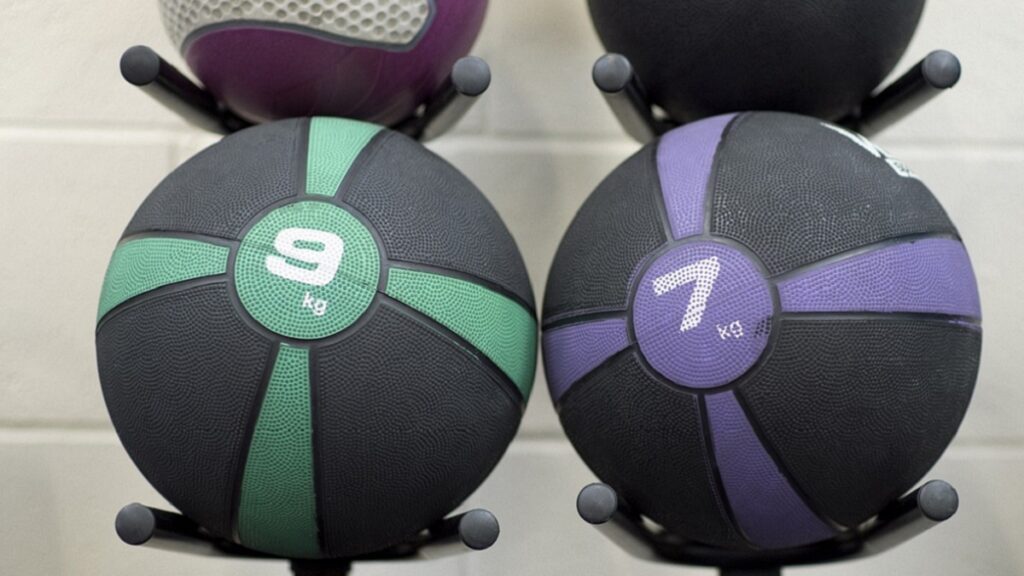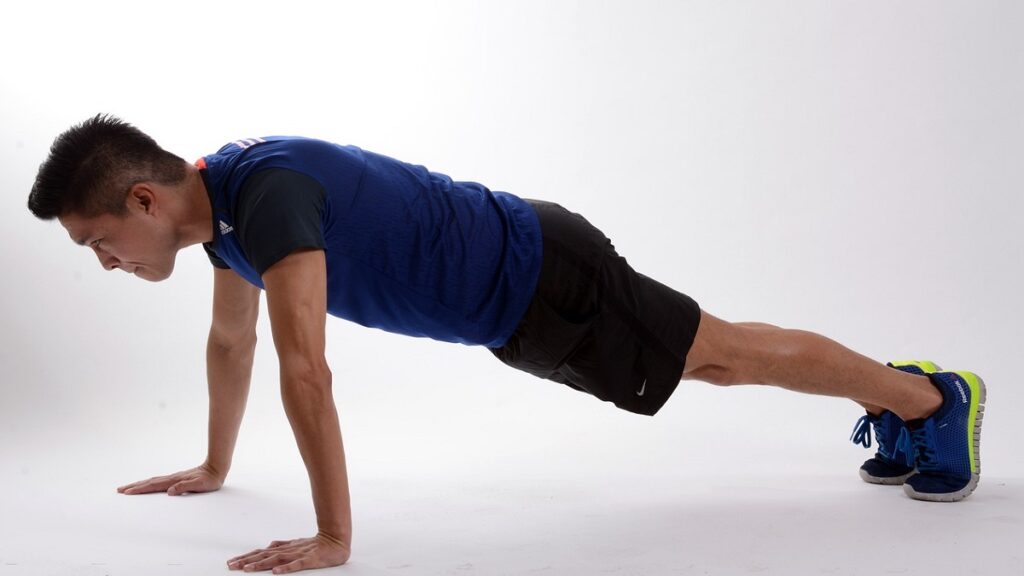A barbell overhead pressing workout called the behind the neck press entails movement from behind the neck, resting on the shoulders, and extending above the head. You can get numerous behind the neck shoulder press benefits if you exercise efficiently.
Behind the neck, shoulder press benefits include increased shoulder strength and stability. The dumbbell press is the best for shoulders. Pressing behind the back is better because it strengthens the rotator cuff muscles. You can press behind the neck with shoulders to avoid injuries.
The behind the neck push press is another comparable exercise that trainers and players can use to improve shoulders, overhead placement, and upper back support.
In this post, I will discuss the advantages of behind the neck push presses for weightlifters and how they can incorporate them into their regular workouts.
Behind the Neck Shoulder Press Benefits
Working your shoulders, upper back, and upper arms is an excellent way to improve upper body strength. It also enhances the mobility and stability of the shoulder.
The behind the neck shoulder press benefits include enhanced jerking performance and your capacity to maintain a lower back brace and pack while doing heavy squats.
A stable and mobile shoulder also reduces the likelihood of shoulder pain and harm.
Here are some additional advantages of the behind the neck shoulder press to consider.
Increased Shoulder Strength
Your shoulders will be put to new tests and strengthened due to the bar path’s angle. That is a great exercise to improve overhead strength, just like the military press.
Builds up Muscle Mass
The exercise, designed for hypertrophy, can be a potent muscle developer for your shoulders and upper back. It’s, therefore, an essential behind the neck shoulder press exercise.
Firm Shoulders
Behind the neck press is excellent for developing strong shoulders and complete overhead stability. It also benefits many other exercises like jerks and snatches.
By performing shoulder presses behind the neck, you may exert a direct strain on your deltoids as opposed to a traditional shoulder press, which distributes some of the force across your chest.
Change the Intensity of Your Shoulder Workouts
The shoulders are intricate joints that require cautious attention when exercising. Otherwise, you might not reap all the behind the neck shoulder press benefits!
You can alter the direction of the weight on your shoulders by using this additional pressing variation, which also enables you to recognize and eliminate asymmetries, strength limitations, and mobility blind spots.
The anterior deltoids become overworked if you consistently press your head forward. You can fix this by pressing behind your neck as well.
Upper Back Strength
This exercise can help develop the upper back, trapezoid, and posterior shoulders, which are extremely important in lockout stability and packing of the upper back. In addition, they provide similar benefits as the regular push press.
Compared to the front-racked push press, the behind-the-head beginning point of the lift also enables lifters to overload this pressing movement, possibly promoting long-term strength growth. Athletes should always do push press variations (behind the neck and front racked) to achieve their highest overhead performance.
Additional Performance
Shoulder stabilization is essential for joint integrity, force output, and effectiveness overhead in the snatch and jerk.
This push-press variation can develop the muscles and connective tissues that are stressed during pulls while also increasing the shoulder range of motion (split, power, and squat).
Last but not least, these can aid in overloading the triceps to improve stability and strength during overhead lockouts since lifters may be able to undertake more loading from the behind-the-head position (the barbell is placed precisely over the hips).
Drive Mechanics and the Jerk Dip
Last but not least, this behind the neck shoulder press exercise replicates the precise dip and drive mechanics used in jerking movements.
The exercise is essential for beginners who wish to acquire a vertical bar path, overhead flexibility, and ingrain jerking mechanics. It also aids in building the necessary muscles. Besides, it helps intermediate and advanced athletes progress with greater loads.
Which Shoulder Press Is Best?
The dumbbell shoulder press is ideal for developing shoulder strength and muscle endurance. Depending on behind the neck shoulder press benefits you want and the power level, you can perform this exercise with one or two dumbbells.
Stand tall with your feet width apart to complete the dumbbell shoulder press. Press the dumbbells straight up until your arms are entirely extended while holding one in each component at shoulder height. For 8 –12 repetitions, lower the weights back to shoulder level.
Muscular shoulders look better and improve posture. They are also essential in shoulder joint protection. Moreover, they help you get a healthy neck and upper back. When one region is strong, the others often follow suit. It works like a chain reaction.
Why Behind the Neck Press Is Better
The exercise is useful in strengthening and conditioning the rotator cuffs, upper body, and shoulders. Undoubtedly, many weightlifters love big, strong, and muscular-like shoulders.
For this to happen, your shoulders must be exercised with a range of exercises and regularly subjected to progressive overload, just like any other muscle group.
By performing behind the neck shoulder press, you may exert a direct strain on your deltoids as opposed to a traditional shoulder press, which distributes some of the force across your chest. It is a great approach to increase the strength in your upper body because it also works your shoulders, upper back, and upper arms. It also improves the mobility and stability of the shoulder.
Additionally, it relieves pressure from constantly loading the shoulder from the front and aids in locating and eliminating movement flaws and strength imbalances.
Should I Do Shoulder Press Behind the Head?
You should include behind the head pressing in your training if you have a strong posture and an excellent overhead position, providing it does not cause you any pain or discomfort. If it does, you still need to focus on strengthening, improving the range of motion, and stabilizing your shoulders.
Why? Continually pushing in front of your body overworks your anterior deltoids. So, including behind the neck pressing in your training lessens the stress your shoulders endure over time. Your workout regimen will be more comprehensive if you do behind the neck pressing.
However, behind the neck pushes twist your rotator cuffs into an unusual posture, subjecting them to severe torque stress. In contrast, their intended job is to rotate muscles only into poses from which they may flex adequately.
That explains why many athletes performing behind the neck push at their maximum weight get rotator cuff issues.
Should I Shoulder Press in Front or Behind the Neck?
You can press behind your neck quickly and safely if you are an Olympic trainer or an experienced weight lifter.
However, since pressing from the front is preferable for growing your shoulders, you can begin by pressing in front of the neck for novices and return to the starting position.
One of the many behind the neck shoulder press benefits is developing front-to-back thickness or expanding the shoulders. Depending on how effectively you complete them.
So, to prevent injuries, you need to know how to conduct them well. For example, when you have the bar behind your head, your deltoids are pulled back and forth, bearing the stress behind your shoulder rather than distributing it uniformly throughout the three deltoid heads across the shoulder girdle.
Is Behind the Neck Press Better than Military Press?
If you want to increase the weight on your shoulders, the behind the neck barbell press is better than the military press.
However, the military press is safer when considering the hazards to the rotator cuff muscles. Military presses are the best for delts because they concentrate on the intended muscle.
The rest of your upper back, including your lats, rhomboids, teres, spinatus, and traps, take some of the strain from behind the neck pushes. In other words, the stress on your deltoids and shoulder girdle is somewhat offset by your back.
That explains why behind the neck presses make you “stronger” than militaries. Let me explain more. Massive leverage is used through a more stabilized power plane by stacking all those back muscles on top of one another and pushing upward together.
For the upper back, that’s great, but it deprives your shoulder of the fair part of the work. The evidence for this statement is that while your posterior and lateral delt heads will experience relatively little fatigue during behind the neck presses, around half the arc of your front delts will experience a significant burn.
Additionally, behind the neck presses distort your rotator cuffs into an unnatural posture where they experience detrimental torque stress. Instead, they should only rotate muscles into postures from which they can flex adequately.
That explains why many athletes performing behind the neck push at their maximum weight get rotator cuff issues.
What Does Behind the Neck Press Do?
The behind the neck press strengthens the shoulder by working the:
- Shoulders’ front, outer, and back deltoids;
- Traps, or trapezius; and triceps brachii (back upper arm)
- Anterior serratus (armpit over rib cage).
You can perform the behind the neck press in a standing position that works out the core and lower body.
The rotator cuff muscles that support your shoulder joints are under much strain during a behind the neck press. The situation is awkward as well. You run the risk of tearing a shoulder muscle if you have restricted shoulder movement or if you use much weight.
Besides, you can also harm your neck. When descending, the barbell may strike your neck or the back of your head. What’s more? Your neck muscles are also put under stress.
Because of these dangers, you should only try a behind the neck press if you have:
- Sufficient shoulder range of motion and stability
- A stable trunk behavior
- Excellent mobility of the thoracic (upper) spine
If not, you can try other overhead press variations.
Is It Ok to Do Shoulder Press Behind the Head?
When performed in the proper form, the behind the neck shoulder press is a powerful exercise with several advantages for activating and growing your deltoids. However, it may be wise to avoid this exercise if you have had shoulder issues or past shoulder injuries.
Undoubtedly, an exercise that has progressively developed a terrible name is the behind the neck press. If performed incorrectly, the exercise can put you in a highly vulnerable posture, jeopardize your shoulders, and cause serious harm. That is not always the case, though. If done correctly, it can be a workout that engages several deltoid muscle fibers.
By performing shoulder presses behind the neck, you may exert a direct strain on your deltoids as opposed to a traditional shoulder press, which distributes some of the force across your chest. The behind the neck press comes in a few different forms, each with unique advantages.
Also, learn to correctly do behind the neck press variations to develop your deltoids, increase posterior strength, and enhance shoulder socket mobility.
Can You Lift More with Behind the Neck Press?
One of the behind the neck shoulder press benefits is that you get to lift more weight. That results from the barbell being directly above the hips and spinal column. You can effectively stimulate the muscles around the shoulder blades using overhead presses.
More specifically, the posterior and lateral deltoid appear to be stimulated more by the back overhead exercise performed with a barbell or a machine than by the front overhead exercise or the front handgrip of the shoulder press.
On the other hand, both front presses favor pectoralis major and triceps brachii excitation. Additionally, less stable overhead trajectories require more stability than more stable actions when utilizing a barbell.
Such include the shoulder press, where the posterior and medial deltoid and, to a lesser extent, the anterior deltoid and triceps brachii simultaneously act to achieve this goal.
What Is a Good Weight for Behind Neck Shoulder Press?
A male lifter’s typical behind the neck shoulder press load is 65 kg (1RM). That’s a remarkable lift that places you in the intermediate strength level. The recommended weight for male novices is 51 lb (1RM), which is still excellent compared to the average person.
Many people are only fully capable of sustaining high loads while still being able to rise comfortably from this posture if they are one of the rare people with outstanding shoulder mobility. As a result, most people can lift less weight than they can with other shoulder press variations.
Along with rotator cuff problems, behind the neck presses force your neck into flexion, which is not a good posture for secure and comfortable lifts. Yet, the positioning behind the neck may provide you with a broader range of motion. However, it is insufficient to compensate for losing the ability to work from a neutral spine.
Does Military Press Make Your Shoulders Wider?
Shoulder presses are necessary to develop a set of broad, rounded deltoids (shoulders). The overhead dumbbell presses can be effective because they stimulate more shoulder muscles than other press variations, such as the bench press.
After all, stabilizing the weights during each set will engage the upper back and triceps.
Although the overhead dumbbell press is primarily a shoulder exercise, other upper body muscles are crucial for stabilizing the body and completing the exercise.
Here are the muscles it engages in addition to the shoulders.
Deltoids
Technically, the deltoid muscles (shoulders) are muscle groups with three heads: The anterior (front), lateral (side), and posterior (back/rear). The overhead dumbbell press is a thorough shoulder workout that recruits all three heads.
Triceps
The triceps muscle will be activated throughout any pressing exercise. However, it will be especially active during the last range of motion necessary to attain a complete lockout posture.
Your triceps get worked during an overhead dumbbell press whenever you raise the weight to complete lockout at brow level.
Upper Back
The term “upper back” refers to a broad group of muscles that often includes the teres, rear deltoids, trapezius, and rhomboids. These muscles function in overlapping and are the best ways to stabilize and move the scapula.
The overhead dumbbell press strengthens your upper back as the loads are supported at the bottom position, working statically and more actively to help maintain a stable thoracic position for pressing.
Is Behind The Neck Press Good For Mobility?
Yes, the behind the neck press is great for mobility. In addition, stability and strength training are some other of the renowned behind the neck shoulder press benefits. You can do this workout like a jerk or a push press by using your legs.
The lateral and front deltoids are the primary muscles worked when you do behind the neck presses. On the other hand, the triceps and trapezius are the secondary muscles worked during the workout.
However, this workout is not ideal for people with severe mobility and stability issues, as it can strain your shoulders and neck. So, it is best to avoid it. Alternatively, seek medical advice before doing it.
Winding Up
When performed correctly, the behind the neck shoulder press is a powerful exercise with various benefits for your deltoids’ activation and growth. There are many behind the neck shoulder press benefits if you are an experienced athlete. However, it may be wise to avoid this exercise if you have had shoulder issues or a shoulder injury.
The overhead press is one of the most efficient shoulder workouts to increase strength and lean muscle mass. Although overhead lifts can undoubtedly increase shoulder strength and muscular mass, they only function correctly when you do them in the proper form. Consequently, it is crucial to begin slowly.



